A
Auto Express
Guest
The Toyota Hilux has been on sale for around half a century, and its reputation for go-anywhere reliability has won it friends around the world. An incredible 18 million examples have been produced since 1968, but the latest version is offered with an array of luxury features that make it more appealing than ever.
At least that’s the case with the Double Cab version, which competes for attention from owner-drivers wanting to combine workaday practicality with their family lifestyle – and more importantly take advantage of the massive tax break available to drivers of company funded ‘commercial vehicles’ with a one tonne load capacity.
It’s a hotly contested segment, with rivals such as the Ford Ranger, Nissan Navara, Mitsubishi L200 and VW Amarok all vying for your cash. That’s why Toyota offers the Hilux for sale in a range of Double Cab trim levels from entry-level Hilux Active – with air conditioning and Bluetooth – right up to the Hilux Invincible X with sat-nav, heated seats and a suite of luxury and safety features such as lane departure warning and pedestrian detection thrown in. The two-door Single Cab and Extra Cab (extended) versions are pure workhorses that don’t attract the lifestyle buyers, so are offered only in basic Active trim.
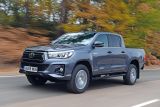
Toyota Hilux front

Toyota Hilux water splash

Toyota Hilux rear
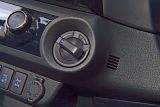
Toyota Hilux mode selection
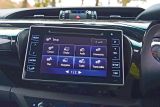
Toyota Hilux infotainment
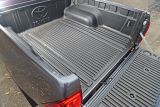
Toyota Hilux load area
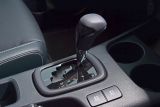
Toyota Hilux gearbox
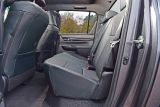
Toyota Hilux rear seats
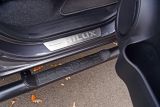
Toyota Hilux kickplates

Toyota Hilux interior
In spite of pandering to the luxury end of the pick-up truck market, the Toyota Hilux has certainly not forgotten its roots. While it’s better-looking, better to drive and better-equipped, it’s still tough as old boots, and has a wider load bay and bigger capacity than any of its predecessors. That said, the latest Hilux – now in its eighth generation – is not a complete redesign, but a heavily updated evolution of the last and it still rides on a leaf-sprung live rear axle.
• Best pick-up trucks
Body styles on offer include standard and wide body versions of the Single Cab – which provide the most load space – while the Extra Cab has a 2+2 seating set-up with cramped rear quarters for occasional use. The Double Cab gives up some of its load space in favour of a five-seater interior.
The interior has been made more attractive, with a design that looks like it came straight out of the Toyota Auris rather than a commercial vehicle. There’s good space for four adults, five at a stretch, while top-spec models are very well equipped, although not cheap.
The Hilux's suspension set-up is designed to cope with heavy loads rather than handling, so the ride can be a little bouncy, but it’s almost a match for the Mitsubishi L200 in terms of the driving experience.
• Toyota Hilux Invincible review
All Hilux models in the UK come with the sole option of a new 2.4-litre four-cylinder diesel engine with 148bhp. It’s mated to either a six-speed manual or an optional six-speed automatic gearbox on top trims. Stop-start technology is available on Icon versions and above, which helps improve fuel economy and emissions figures, while other markets get the choice of a more powerful 2.8-litre engine which won’t arrive here for a while.
The absence of a more powerful unit gives the new V6-engined VW Amarok and twin-turbo Nissan Navara the edge in terms of performance, but every Hilux comes with selectable four-wheel drive and there’s a host of rugged systems to ensure it’s an extremely capable mud-plugger.
With the addition of new eco technology, the Hilux has closed the efficiency gap on rivals such as the Nissan Navara, but still lags behind the more frugal Mitsubishi L200. Fuel economy across the range is separated only by fine margins, with WLTP tests showing the single cab able to achieve 32.4mpg, while Double Cab models offer efficiency of around 29-32mpg. CO2 emissions for the lighter two-door version are rated from 230g/km, with the wide body slightly higher at 242g/km. Double Cab variants are 232-248g/km.
If you’re worried about fuel economy, it’s worth avoiding the six-speed automatic – it drops the mpg figure and emits more CO2. It’s hardly shocking for a two-tonne truck, but not great when you consider the Nissan Navara offers more power and a similar fuel range, while the Mitsubishi L200 provides identical power, but has the ability to cover greater distance on a single tank.
Elsewhere, Toyota is offering the Hilux with a five-year/100,000 mile warranty cover to help it compete with the latest pick-up rivals. The first year is unlimited in terms of mileage, too.
Generous levels of safety kit, including autonomous braking on top models, should help to keep insurance premiums low. Those worried about leaving items in the load bay unsecured should look at the range of load cover options, including a hard-top for around £1,800. Depreciation-wise, given the Toyota badge always carries serious credibility on the used market and the Hilux is a popular model, we expect the Hilux to hold its value as well as (if not better than) rivals.
As a pick-up truck and a commercial vehicle, the Hilux’s most important trait is how much it can carry and pull. Toyota is fully aware of this, which is why the new-generation model has a bigger load bay and towing capacity than the old one.
The Hilux itself is longer, wider and lower than the previous generation model, which benefits practicality. The Hilux’s load bay length varies from 1,525mm in the double cab model to 2,315mm in the single cab. That’s pretty much on a par with rivals, but it’s width where the Hilux has made great strides.The load area on all models is a full 130mm wider than before, which makes it bigger than both the Navara and L200. If you’re often loading up wide items, it may be the best choice for you.
The single cab gets the usual format of two seats, whereas the extra-cab uses two tiny rear-hinged suicide doors opening up to reveal a pair of cinema-style folding seats. They won’t be the most comfortable to sit in, however, and are only designed for occasional use.

Toyota Hilux front

Toyota Hilux water splash

Toyota Hilux rear

Toyota Hilux mode selection

Toyota Hilux infotainment

Toyota Hilux load area

Toyota Hilux gearbox

Toyota Hilux rear seats

Toyota Hilux kickplates

Toyota Hilux interior
If you plan on carrying passengers regularly, you’ll want the double cab, which is also the only bodystyle available on top-spec Invincible trims. There’s reasonable amounts of head and legroom in the back for two larger adults (and three at a push), and it’s roughly on a par with rivals in that area. It’s easy to see why the vast majority of UK buyers are expected to opt for the double cab
Whichever variant you choose, the Hilux can carry at least 1,085kg in its load bay, while the Active Double Cab sees that rise to 1,130kg. That’s better than the previous Hilux, but the Nissan Navara still just edges it on carrying ability. However, every Hilux can pull at least 3,500kg, which is on par with the majority of its rivals.
Reputation isn’t everything, but Toyota has been known as a maker of very durable products, and the Hilux in particular has always been an extremely tough and reliable vehicle.
The rugged box frame chassis and selectable 4x4 system underneath is a proven set-up, although the 2.4-litre diesel engine in the new Hilux has only been around since 2015. The engine uses some advanced new tech to boost efficiency and performance, but we’d be surprised if it didn’t turn out to be as reliable long-term as the old-tech diesel units.
It’s really safety where things have improved for the Hilux, though. The model range now offers seven airbags including curtain airbags and one for the driver’s knee, while all versions except the most basic single cab receive front and rear seatbelt pre-tensioners. Double cab models also get ISOFIX child seat mountings and front fog lights as standard.
It’s not just the things you can see, though, as under the skin every Hilux has a wide array of safety systems installed. Every model gets ABS, Emergency Brake Assist, Vehicle Stability Control, Hill Start Assist and Trailer Sway Control, while double cabs also include Downhill Assist Control. Toyota’s Safety Sense package also makes its way across from cars like the Auris and Avensis and includes autonomous emergency braking with pedestrian detection, lane departure assist and (on certain models) road sign recognition. It’s a level of tech that certainly shows up Hilux models of old, and a number of rival pick-ups.
In terms of crash protection, Euro NCAP awarded the standard Hilux only three stars for safety in 2016, although that rises to a full five-star score with Safety Sense fitted. Given that Toyota is claiming the ladder-frame chassis is 20% stronger than before, it should withstand big collisions better than the old car. Security-wise, all models get an alarm and immobiliser, although the Single Cab Wide Body version doesn’t receive a locking tailgate.
The Hilux, like most pick-ups, feels pretty enormous when you’re trying to park it. Thankfully, all models except Active get a reversing camera as standard, although Nissan goes one better in the Navara with the 360-degree Around View Monitor.
The Hilux’s driving experience is improved in pretty much every area over the rather uncivilised old model. Make no mistake, though, you’re still not going to be convinced you’re driving anything other than a commercial vehicle.
The 2.4-litre four-cylinder diesel engine now produces 148bhp and 400Nm of torque from as little as 1,600rpm thanks to a variable geometry turbo. In isolation that’s gutsy enough for a pick-up, but the Mitsubishi L200, updated VW Amarok, Nissan Navara and Ford Ranger all offer more powerful units. Other markets can opt for a 2.8-litre diesel, which is more powerful and torquey but doesn’t quite meet the emissions regulations over here yet.
As it is, Hilux performance is adequate but not exceptional: A 0-62mph time of 13.2 seconds illustrates this. That drops to 12.7 seconds with the six-speed auto, but it’s still worth avoiding as it holds onto ratios for far too long, and takes an age to kickdown. It means you end up hearing the rather noisy engine revving out more than you’d like.
It’s more refined with the manual gearbox, but it’s still quite a way off the refinement levels you’d get with an SUV. Most of the power is below 3,000rpm, where the Hilux feels sprightly enough.

Toyota Hilux front

Toyota Hilux water splash

Toyota Hilux rear

Toyota Hilux mode selection

Toyota Hilux infotainment

Toyota Hilux load area

Toyota Hilux gearbox

Toyota Hilux rear seats

Toyota Hilux kickplates

Toyota Hilux interior
In terms of handling, the Hilux’s improvement over the old model is more evident. Gone is the wayward feel and constant bounciness, replaced by accurate steering, reasonable body control and a comfortable ride on smooth roads. There’s plenty of tyre squeal and body lean if you push too hard, but that’s not what pick-ups are designed for.
The traditional bouncy ride returns on rutted roads, but the easiest solution for this is to weigh down the load bay with some cargo which settles things reasonably well. A Navara is generally calmer in terms of ride comfort, however.
Manoeuvrability isn’t too bad in the Hilux around town, thanks to light controls for a truck and a decent turning circle. Road and wind noise are well suppressed at speed, and the Hilux makes a surprisingly good (if uneconomical) motorway cruiser.
Even if the driving experience doesn’t quite manage to convince you you’re driving an SUV, the interior goes some way to doing so. It’s a considerably less rough and ready place to sit than an Isuzu D-Max and on par with the Nissan Navara for quality.
Toyota understands as much as any pick-up brand that the cabin needs to be robust and able to withstand hard day-to-day working use. The carpets and seats of the Hilux seem well up to the job of ferrying mucky builders or farmers about, but the cabin has also taken on some extra sophistication.

Toyota Hilux front

Toyota Hilux water splash

Toyota Hilux rear

Toyota Hilux mode selection

Toyota Hilux infotainment

Toyota Hilux load area

Toyota Hilux gearbox

Toyota Hilux rear seats

Toyota Hilux kickplates

Toyota Hilux interior
The overall dash design is much like that of a Toyota Auris or Avensis. That might not sound too amazing, but it makes the Hilux one of the nicest pick-ups to sit in. There’s a central touchscreen on top models surrounded by gloss black trim, while the instruments also feature a modern-looking trip display screen in the centre. Build quality is pretty good, too: there are no soft-touch plastics so it doesn’t feel as plush as Toyota’s passenger cars, but it’s not far off. All models receive aux-in and USB ports, along with Bluetooth connectivity, while Icon and Invincible versions include a DAB radio.
There’s better storage in the Hilux than in some pick-ups. There are two gloveboxes – one on the top of the dash and one directly below – and both are a decent size. There’s also a central bin underneath the armrest and two cup holders in the centre of the dash, although the storage bins aren’t huge.
Space in the front is good – it’s not as hemmed-in as some trucks with good leg and elbow-room, although the high floor means taller drivers will have their knees raised, which is a common problem on pick-ups. In the back of the double cab you’ll find enough space for two adults to sit comfortably and three to squeeze in for short journeys. Head and legroom is on par with rivals, although it’s not better than a modern supermini in that regard.
Continue reading...
At least that’s the case with the Double Cab version, which competes for attention from owner-drivers wanting to combine workaday practicality with their family lifestyle – and more importantly take advantage of the massive tax break available to drivers of company funded ‘commercial vehicles’ with a one tonne load capacity.
It’s a hotly contested segment, with rivals such as the Ford Ranger, Nissan Navara, Mitsubishi L200 and VW Amarok all vying for your cash. That’s why Toyota offers the Hilux for sale in a range of Double Cab trim levels from entry-level Hilux Active – with air conditioning and Bluetooth – right up to the Hilux Invincible X with sat-nav, heated seats and a suite of luxury and safety features such as lane departure warning and pedestrian detection thrown in. The two-door Single Cab and Extra Cab (extended) versions are pure workhorses that don’t attract the lifestyle buyers, so are offered only in basic Active trim.

Toyota Hilux front

Toyota Hilux water splash

Toyota Hilux rear

Toyota Hilux mode selection

Toyota Hilux infotainment

Toyota Hilux load area

Toyota Hilux gearbox

Toyota Hilux rear seats

Toyota Hilux kickplates

Toyota Hilux interior
In spite of pandering to the luxury end of the pick-up truck market, the Toyota Hilux has certainly not forgotten its roots. While it’s better-looking, better to drive and better-equipped, it’s still tough as old boots, and has a wider load bay and bigger capacity than any of its predecessors. That said, the latest Hilux – now in its eighth generation – is not a complete redesign, but a heavily updated evolution of the last and it still rides on a leaf-sprung live rear axle.
• Best pick-up trucks
Body styles on offer include standard and wide body versions of the Single Cab – which provide the most load space – while the Extra Cab has a 2+2 seating set-up with cramped rear quarters for occasional use. The Double Cab gives up some of its load space in favour of a five-seater interior.
The interior has been made more attractive, with a design that looks like it came straight out of the Toyota Auris rather than a commercial vehicle. There’s good space for four adults, five at a stretch, while top-spec models are very well equipped, although not cheap.
The Hilux's suspension set-up is designed to cope with heavy loads rather than handling, so the ride can be a little bouncy, but it’s almost a match for the Mitsubishi L200 in terms of the driving experience.
• Toyota Hilux Invincible review
All Hilux models in the UK come with the sole option of a new 2.4-litre four-cylinder diesel engine with 148bhp. It’s mated to either a six-speed manual or an optional six-speed automatic gearbox on top trims. Stop-start technology is available on Icon versions and above, which helps improve fuel economy and emissions figures, while other markets get the choice of a more powerful 2.8-litre engine which won’t arrive here for a while.
The absence of a more powerful unit gives the new V6-engined VW Amarok and twin-turbo Nissan Navara the edge in terms of performance, but every Hilux comes with selectable four-wheel drive and there’s a host of rugged systems to ensure it’s an extremely capable mud-plugger.
With the addition of new eco technology, the Hilux has closed the efficiency gap on rivals such as the Nissan Navara, but still lags behind the more frugal Mitsubishi L200. Fuel economy across the range is separated only by fine margins, with WLTP tests showing the single cab able to achieve 32.4mpg, while Double Cab models offer efficiency of around 29-32mpg. CO2 emissions for the lighter two-door version are rated from 230g/km, with the wide body slightly higher at 242g/km. Double Cab variants are 232-248g/km.
If you’re worried about fuel economy, it’s worth avoiding the six-speed automatic – it drops the mpg figure and emits more CO2. It’s hardly shocking for a two-tonne truck, but not great when you consider the Nissan Navara offers more power and a similar fuel range, while the Mitsubishi L200 provides identical power, but has the ability to cover greater distance on a single tank.
Elsewhere, Toyota is offering the Hilux with a five-year/100,000 mile warranty cover to help it compete with the latest pick-up rivals. The first year is unlimited in terms of mileage, too.
Generous levels of safety kit, including autonomous braking on top models, should help to keep insurance premiums low. Those worried about leaving items in the load bay unsecured should look at the range of load cover options, including a hard-top for around £1,800. Depreciation-wise, given the Toyota badge always carries serious credibility on the used market and the Hilux is a popular model, we expect the Hilux to hold its value as well as (if not better than) rivals.
As a pick-up truck and a commercial vehicle, the Hilux’s most important trait is how much it can carry and pull. Toyota is fully aware of this, which is why the new-generation model has a bigger load bay and towing capacity than the old one.
The Hilux itself is longer, wider and lower than the previous generation model, which benefits practicality. The Hilux’s load bay length varies from 1,525mm in the double cab model to 2,315mm in the single cab. That’s pretty much on a par with rivals, but it’s width where the Hilux has made great strides.The load area on all models is a full 130mm wider than before, which makes it bigger than both the Navara and L200. If you’re often loading up wide items, it may be the best choice for you.
The single cab gets the usual format of two seats, whereas the extra-cab uses two tiny rear-hinged suicide doors opening up to reveal a pair of cinema-style folding seats. They won’t be the most comfortable to sit in, however, and are only designed for occasional use.

Toyota Hilux front

Toyota Hilux water splash

Toyota Hilux rear

Toyota Hilux mode selection

Toyota Hilux infotainment

Toyota Hilux load area

Toyota Hilux gearbox

Toyota Hilux rear seats

Toyota Hilux kickplates

Toyota Hilux interior
If you plan on carrying passengers regularly, you’ll want the double cab, which is also the only bodystyle available on top-spec Invincible trims. There’s reasonable amounts of head and legroom in the back for two larger adults (and three at a push), and it’s roughly on a par with rivals in that area. It’s easy to see why the vast majority of UK buyers are expected to opt for the double cab
Whichever variant you choose, the Hilux can carry at least 1,085kg in its load bay, while the Active Double Cab sees that rise to 1,130kg. That’s better than the previous Hilux, but the Nissan Navara still just edges it on carrying ability. However, every Hilux can pull at least 3,500kg, which is on par with the majority of its rivals.
Reputation isn’t everything, but Toyota has been known as a maker of very durable products, and the Hilux in particular has always been an extremely tough and reliable vehicle.
The rugged box frame chassis and selectable 4x4 system underneath is a proven set-up, although the 2.4-litre diesel engine in the new Hilux has only been around since 2015. The engine uses some advanced new tech to boost efficiency and performance, but we’d be surprised if it didn’t turn out to be as reliable long-term as the old-tech diesel units.
It’s really safety where things have improved for the Hilux, though. The model range now offers seven airbags including curtain airbags and one for the driver’s knee, while all versions except the most basic single cab receive front and rear seatbelt pre-tensioners. Double cab models also get ISOFIX child seat mountings and front fog lights as standard.
It’s not just the things you can see, though, as under the skin every Hilux has a wide array of safety systems installed. Every model gets ABS, Emergency Brake Assist, Vehicle Stability Control, Hill Start Assist and Trailer Sway Control, while double cabs also include Downhill Assist Control. Toyota’s Safety Sense package also makes its way across from cars like the Auris and Avensis and includes autonomous emergency braking with pedestrian detection, lane departure assist and (on certain models) road sign recognition. It’s a level of tech that certainly shows up Hilux models of old, and a number of rival pick-ups.
In terms of crash protection, Euro NCAP awarded the standard Hilux only three stars for safety in 2016, although that rises to a full five-star score with Safety Sense fitted. Given that Toyota is claiming the ladder-frame chassis is 20% stronger than before, it should withstand big collisions better than the old car. Security-wise, all models get an alarm and immobiliser, although the Single Cab Wide Body version doesn’t receive a locking tailgate.
The Hilux, like most pick-ups, feels pretty enormous when you’re trying to park it. Thankfully, all models except Active get a reversing camera as standard, although Nissan goes one better in the Navara with the 360-degree Around View Monitor.
The Hilux’s driving experience is improved in pretty much every area over the rather uncivilised old model. Make no mistake, though, you’re still not going to be convinced you’re driving anything other than a commercial vehicle.
The 2.4-litre four-cylinder diesel engine now produces 148bhp and 400Nm of torque from as little as 1,600rpm thanks to a variable geometry turbo. In isolation that’s gutsy enough for a pick-up, but the Mitsubishi L200, updated VW Amarok, Nissan Navara and Ford Ranger all offer more powerful units. Other markets can opt for a 2.8-litre diesel, which is more powerful and torquey but doesn’t quite meet the emissions regulations over here yet.
As it is, Hilux performance is adequate but not exceptional: A 0-62mph time of 13.2 seconds illustrates this. That drops to 12.7 seconds with the six-speed auto, but it’s still worth avoiding as it holds onto ratios for far too long, and takes an age to kickdown. It means you end up hearing the rather noisy engine revving out more than you’d like.
It’s more refined with the manual gearbox, but it’s still quite a way off the refinement levels you’d get with an SUV. Most of the power is below 3,000rpm, where the Hilux feels sprightly enough.

Toyota Hilux front

Toyota Hilux water splash

Toyota Hilux rear

Toyota Hilux mode selection

Toyota Hilux infotainment

Toyota Hilux load area

Toyota Hilux gearbox

Toyota Hilux rear seats

Toyota Hilux kickplates

Toyota Hilux interior
In terms of handling, the Hilux’s improvement over the old model is more evident. Gone is the wayward feel and constant bounciness, replaced by accurate steering, reasonable body control and a comfortable ride on smooth roads. There’s plenty of tyre squeal and body lean if you push too hard, but that’s not what pick-ups are designed for.
The traditional bouncy ride returns on rutted roads, but the easiest solution for this is to weigh down the load bay with some cargo which settles things reasonably well. A Navara is generally calmer in terms of ride comfort, however.
Manoeuvrability isn’t too bad in the Hilux around town, thanks to light controls for a truck and a decent turning circle. Road and wind noise are well suppressed at speed, and the Hilux makes a surprisingly good (if uneconomical) motorway cruiser.
Even if the driving experience doesn’t quite manage to convince you you’re driving an SUV, the interior goes some way to doing so. It’s a considerably less rough and ready place to sit than an Isuzu D-Max and on par with the Nissan Navara for quality.
Toyota understands as much as any pick-up brand that the cabin needs to be robust and able to withstand hard day-to-day working use. The carpets and seats of the Hilux seem well up to the job of ferrying mucky builders or farmers about, but the cabin has also taken on some extra sophistication.

Toyota Hilux front

Toyota Hilux water splash

Toyota Hilux rear

Toyota Hilux mode selection

Toyota Hilux infotainment

Toyota Hilux load area

Toyota Hilux gearbox

Toyota Hilux rear seats

Toyota Hilux kickplates

Toyota Hilux interior
The overall dash design is much like that of a Toyota Auris or Avensis. That might not sound too amazing, but it makes the Hilux one of the nicest pick-ups to sit in. There’s a central touchscreen on top models surrounded by gloss black trim, while the instruments also feature a modern-looking trip display screen in the centre. Build quality is pretty good, too: there are no soft-touch plastics so it doesn’t feel as plush as Toyota’s passenger cars, but it’s not far off. All models receive aux-in and USB ports, along with Bluetooth connectivity, while Icon and Invincible versions include a DAB radio.
There’s better storage in the Hilux than in some pick-ups. There are two gloveboxes – one on the top of the dash and one directly below – and both are a decent size. There’s also a central bin underneath the armrest and two cup holders in the centre of the dash, although the storage bins aren’t huge.
Space in the front is good – it’s not as hemmed-in as some trucks with good leg and elbow-room, although the high floor means taller drivers will have their knees raised, which is a common problem on pick-ups. In the back of the double cab you’ll find enough space for two adults to sit comfortably and three to squeeze in for short journeys. Head and legroom is on par with rivals, although it’s not better than a modern supermini in that regard.
Continue reading...
